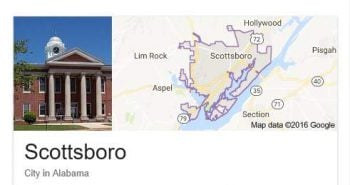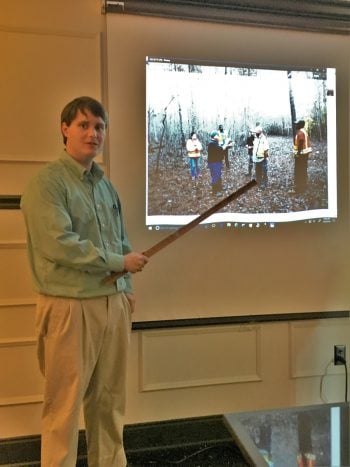Jonathan Neighbors, EA of Cook & Co. Tax Advisors gives Presentation on Birmingham Tax Court Case
The tax court case was on the docket for federal court in Birmingham and only weeks away, when the IRS Appeals Officer sent a letter to Neighbors requesting a telephone conference. The call was scheduled for 9:00 am on September 23rd with Neighbors, the Appeals Officer and myself. As a result of that conference, the Internal Revenue Service conceded every issue that they had previously denied, which represented all of the contested issues in disagreement between the taxpayer representative and the auditor.
Background
The tax case involved an 83 acre Tree Farm located at Scottsboro in Jackson County. On November 26, 2014, the taxpayer was notified that the IRS was auditing his 2013 federal income tax return and at issue would be depreciation and Section 179 expense on Schedule F1.
 During the examination process, the IRS issued three separate Examination Reports in the course of the audit; 1) In the first report (dated June 4, 2015) the IRS denied the Tree Farm loss claiming “the taxpayer has not established material participation per the Schedule F activity or produced evidence of an ongoing business operation.” 2) In the second exam report (dated August 4, 2015), the IRS auditor disallowed the Tree Farm loss stating, “In 2013, farm expenses deducted in excess of farm income were disallowed for lack of material participation and suspended until they can be matched against farm income.” 3) In Audit Report #3 (dated January 5, 2016) the IRS asserted that “the farm expenses shown on the tax return were not ordinary and necessary.”
During the examination process, the IRS issued three separate Examination Reports in the course of the audit; 1) In the first report (dated June 4, 2015) the IRS denied the Tree Farm loss claiming “the taxpayer has not established material participation per the Schedule F activity or produced evidence of an ongoing business operation.” 2) In the second exam report (dated August 4, 2015), the IRS auditor disallowed the Tree Farm loss stating, “In 2013, farm expenses deducted in excess of farm income were disallowed for lack of material participation and suspended until they can be matched against farm income.” 3) In Audit Report #3 (dated January 5, 2016) the IRS asserted that “the farm expenses shown on the tax return were not ordinary and necessary.”
Prior to that third and final Examination Report, Neighbors, Cook, the IRS Auditor and the Auditor’s Manager held a meeting at the Internal Revenue Service office in Huntsville. At the conclusion of that meeting, everyone was well aware that the outcome of the case would not be agreed upon. Cook and Neighbors informed the Manager of the taxpayer’s intent to appeal.
Neighbors said, ” in summary, the IRS wanted to disallow the farm loss in their first report, then they backed up and wanted to just suspend the loss in the second report, and finally, in their third report they changed their position and reasons for disallowing the Tree Farm Loss altogether.
At the audit meeting the IRS Manager stated that “there was no substantial economic activity in 2013 because the taxpayer had not sold any timber that year.” I told the manager that there was in fact very substantial economic activity that year. The taxpayer purchased and placed in service $66,817 worth of equipment. The fact that there were no timber sales that year was not a factor.
At Issue – The primary issue in this case centered around the allowance or disallowance of a Timber Farm Loss in the amount of ($69,142).
The Internal Revenue Service wanted to deny the loss basically because the taxpayer had no income from this activity in 2013, the first year the timber farm was shown on a tax return.
In the first audit report the IRS alleged that the taxpayer should owe an additional $142,020. This outcome was predicated on disallowing the farm loss and adding bank transfers as income to the taxpayer’s Schedule C. In the second audit report the IRS asserted that the taxpayer should owe an additional $50,962. In the third audit report the IRS persisted, requesting an additional $45,235.
At a stale mate, Neighbors filed his Appeal to Tax Court on February 10, 2016.
As is often the case, the matter was resolved favorably before even getting to court. The attorney representing the IRS responded to Neighbor’s brief through the court by admitting sixty percent of Neighbors’ assertions in the petition. The forty percent he denied “due to lack of sufficient information presently available to respondent.” Tax Court cases always go to an Appeals Officer before the court date to see if they can be resolved.
__________________________________
NOTES TO CASE:
IRC SECTION 212 STATES THAT IN THE CASE OF AN INDIVIDUAL, THERE SHALL BE ALLOWED AS A DEDUCTION ALL THE ORDINARY AND NECESSARY EXPENSES PAID OR INCURRED DURING THE TAXABLE YEAR FOR THE MANAGEMENT, CONSERVATION, OR MAINTENANCE OF PROPERTY HELD FOR THE PRODUCTION OF INCOME.
FORM 5213: ELECTION TO POSTPONE DETERMINATION AS TO WHETHER THE PRESUMPTION APPLIES THAT AN ACTIVITIY IS ENGAGED IN FOR PROFIT.
The use of Form 5213 is to elect to postpone an IRS determination as to whether the presumption applies that an activity is engaged in for profit. Jonathan Neighbors, EA filed form 5213 on July 1, 2015 within 60 days of receiving the initial disagreed Audit Report on June 8, 2015. Neighbors stated with his filing that “the taxpayer is not in the process of breeding, training, showing, or racing horses. The taxpayer is in the act of actively running a tree farm.”
Note: The IRS Auditor and Manager ignored the Fm 5213 providing NO RESPONSE to the Power of Attorney (POA). At the IRS Manager meeting, when questioned as to why IRS did not process the Fm 5213 the manager responded, we have never encountered that form before and did not know what it was. We sent a request for clarification from a “higher-up” but never got a response. The IRS Manager then later claimed that our filing of Form 5213 was evidence that the taxpayer had no business purpose.
Submission of Form 5213 is NOT evidence to support “no business purpose”. It is the IRS prescribed method to respond to their challenge. We never received a response to the filing, other than the statement that auditor and manager had never heard of the form.
 Publication 225 states “If you are starting out in farming and do not have 3 (or 2) years showing a profit, you may want to take advantage of this presumption later, after you have had the 5 (or 7) years of experience allowed by the test.
Publication 225 states “If you are starting out in farming and do not have 3 (or 2) years showing a profit, you may want to take advantage of this presumption later, after you have had the 5 (or 7) years of experience allowed by the test.
You can choose to do this by filing Form 5213. Filing this form postpones any determination that your farming activity is not carried on for profit until 5 (or 7) years have passed since you first started farming. You must file Form 5213 within 3 years after the due date of your return for the year in which you first carried on the activity, or, if earlier, within 60 days after receiving a written notice from the IRS proposing to disallow deductions attributable to the activity.
The benefit gained by making this choice is that the IRS will not immediately question whether your farming activity is engaged in for profit. Accordingly, it will not limit your deductions. Rather, you will gain time to earn a profit in 3 (or 2) out of the first 5 (or 7) years you carry on the farming activity. If you show 3 (or 2) years of profit at the end of this period, your deductions are not limited under these rules. If you do not have 3 (or 2) years of profit (and cannot otherwise show that you operated your farm for profit), the limit applies retroactively to any year in the 5-year (or 7-year) period with a loss.”
IRS Publication 225 Farmer’s Tax Guide states that “You can generally deduct the current costs of operating your farm. Current costs are expenses you do not have to capitalize or include in inventory costs. The ordinary and necessary costs of operating a farm for profit are deductible business expenses. “Ordinary” means what most farmers do and “necessary” means what is useful and helpful in farming.”
“If property you acquire to use in your farm business is expected to last more than one year, you generally cannot deduct the entire cost in the year you acquire it. You must recover the cost over more than one year and deduct part of it each year on Schedule F as depreciation or amortization. However, you can choose to deduct part or all of the cost of certain qualifying property, up to a limit, as a section 179 deduction in the year you place it in service.”
IRS Publication 225 – For more information about timber, see Agriculture Handbook Number 731, Forest Landowners’ Guide to the Federal Income Tax. You can view this publication on the Internet at http://www.fs.fed.us/publications.
Source: http://www.irs.gov/publications/p225/ch04.html
Agriculture Handbook Number 731 encourages taxpayers to “Consider structuring your timber management activity to allow the deduction of qualified expenses against nontimber income when possible.” (on page 4)


Facebook Comments